|

What's
new
Albas
Bourbons
Centifolias
Chinas
Climbers
Damasks
English Roses
Gallicas
Hyb. Bracteatas
Hyb. Musks
Hyb. Perpetuals
Hybrid Teas
Miniatures
Modern Shrubs
Moss Roses
Noisettes
Rugosas
Species
Teas
Site
Index
Email
|
Welcome
to the November 2002 edition of my web site! The roses I write about
are the Old Garden Roses and select shrub and miniature roses of the
20th (and 21st) centuries.
For
tips on rose culture, pruning, propagation and history, see the "Site
Resources Guide" box in the navigation panel at left.
To return to this page, click on the "thorn icon" in the margin
at left. Articles from the previous months are archived and can be viewed
by clicking on the listings in the left margin. Oh, and please don't
write to me for a catalog or pricelist.....this is an information site
only, not a commercial nursery. If you wish to buy roses, see
my sponsor, The Uncommon Rose.
Thanks!
Archiving
the Ralph Moore Miniatures
by Paul Barden
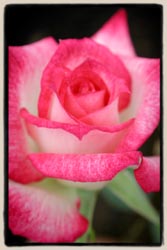 Every
year, new roses are introduced into commerce. Some of these are met
with a lukewarm response from the rose buying public, either because
they are not particularly good (or improved) hybrids or stylistically
they are not what rose growers are looking for. No matter what the reason,
many roses do not survive in commerce beyond their first 10 years after
release. If catalogs stop offering a variety, and the buying public
has moved on to thie current "bigger and better" model, whats
to stop that rose from slipping quietly into obscurity and on further
into extinction? Read on and we'll see. Every
year, new roses are introduced into commerce. Some of these are met
with a lukewarm response from the rose buying public, either because
they are not particularly good (or improved) hybrids or stylistically
they are not what rose growers are looking for. No matter what the reason,
many roses do not survive in commerce beyond their first 10 years after
release. If catalogs stop offering a variety, and the buying public
has moved on to thie current "bigger and better" model, whats
to stop that rose from slipping quietly into obscurity and on further
into extinction? Read on and we'll see.
At
left: 'Toy Clown', from 1966. 'Little
Darling' X 'Magic Wand'
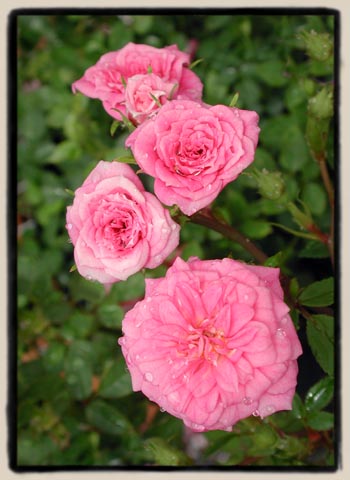 At
a recent lecture on "Misunderstood Roses" by Andrew Schulmann, Andrew
pointed out an excellent example of a rose that nearly never made it
in commerce because it wasn't "the right shape": 'Moonsprite'. It was
a rose that would have been perfectly at home in the company of the
David Austin roses, but at the time of its introduction it was an oddity
and the public didn't take to it well. If it weren't for a few insightful
growers who recognized its merits, it may have been allowed to fall
into extinction. Therein lies the potential fate of most any rose thay
enters commerce. Even the darlings of the newest catalogs, harbingers
of a bright, bold new rose future are subject to the test of time. All
roses must pass this test, it seems; the Old Garden Roses we still have
in commerce remain with us today because they were deemed virtuous above
and beyond their peers, and thus were saved for future generations. At
a recent lecture on "Misunderstood Roses" by Andrew Schulmann, Andrew
pointed out an excellent example of a rose that nearly never made it
in commerce because it wasn't "the right shape": 'Moonsprite'. It was
a rose that would have been perfectly at home in the company of the
David Austin roses, but at the time of its introduction it was an oddity
and the public didn't take to it well. If it weren't for a few insightful
growers who recognized its merits, it may have been allowed to fall
into extinction. Therein lies the potential fate of most any rose thay
enters commerce. Even the darlings of the newest catalogs, harbingers
of a bright, bold new rose future are subject to the test of time. All
roses must pass this test, it seems; the Old Garden Roses we still have
in commerce remain with us today because they were deemed virtuous above
and beyond their peers, and thus were saved for future generations.
At
right: 'Trinket', from 1965
How
do we preserve endangered or rare roses? How do we decide which cultivars
are worthy of our preservation efforts? In a discussion on this topic
I participated in recently, someone lamented the fact that a favorite
rose was apparently being deleted from rose catalogs because the breeder
of that cultivar had an "improved" (and patented) rose available to
supersede the older one. Why, this person asked, must some of these
perfectly wonderful varieties be allowed to fall into obscurity, and
why wasn't anyone doing anything to preserve such roses? Well, I think
that any attempts to archive and protect potentially threatened roses
will be done ostensibly by devoted individuals, not by the commercial
rose industry, whose main motivating force must necessarily be the making
of money.
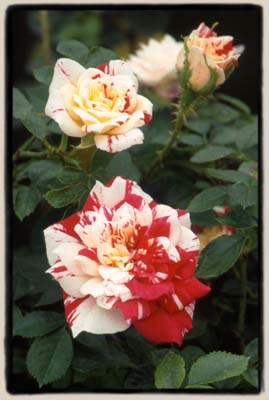 In
the 1960's, rosarians like Graham Thomas began assembling collections
of what remained of the old European roses from the 1800's and previous.
Thomas was certainly one of the first to recognize the need to gather
these roses for the enjoyment of future generations, but he was certainly
not alone in his quest in the decades to come. In America, dedicated
collectors began collaborating in an effort to collect, and in many
instances identify, the "lost" roses that grew hidden in old established
gardens and cemetaries. Banding together as entities such as the Heritage
Roses Group and the recently rejuvenated Heritage
Rose Foundation, these dedicated people work to educate rose
growers and to reconstruct the histories of these living "antiques".
(For a wonderfully detailed account of the efforts and activities of
these preservationists, be sure to read Thomas Christopher's book "In
Search Of Lost Roses") In
the 1960's, rosarians like Graham Thomas began assembling collections
of what remained of the old European roses from the 1800's and previous.
Thomas was certainly one of the first to recognize the need to gather
these roses for the enjoyment of future generations, but he was certainly
not alone in his quest in the decades to come. In America, dedicated
collectors began collaborating in an effort to collect, and in many
instances identify, the "lost" roses that grew hidden in old established
gardens and cemetaries. Banding together as entities such as the Heritage
Roses Group and the recently rejuvenated Heritage
Rose Foundation, these dedicated people work to educate rose
growers and to reconstruct the histories of these living "antiques".
(For a wonderfully detailed account of the efforts and activities of
these preservationists, be sure to read Thomas Christopher's book "In
Search Of Lost Roses")
At
left: 'Strange Music', from 1986. 'Little
Darling' X "33 stripe"
It
is not only the heritage roses of 150 years ago that face the danger
of potential extinction. Every rose introduced into commerce must make
its brave bid for permanence in the realm of the rose growing public.
Considering the thousands of roses man has bred, its not surprising
that so very few of them earn their rosy immortality. This is not to
say that there aren't a great many excellent roses out there, but everyone
I know runs out of room eventually and they must choose which will stay
and which must go! Choices must be made, and its the older varieties
that are usually the ones to get the boot, or in this case, the shovel.
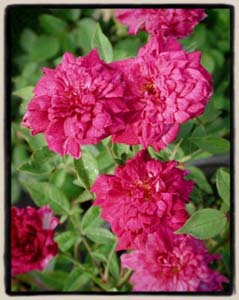 As
most of my readers must know by now, I am an ardent fan of Ralph Moore
and his hybrids. Moore roses have a certain feel about them; an unmistakeable
style that comes from decades of hybridizing refinement and careful
selection coupled with his unique and brilliant vision. Once upon a
time if you had asked me what I thought about miniature roses, my response
would have been a lukewarm "They're nice enough, if you go for
that sort of thing". That was before I met "the Master" Ralph
Moore. My first meeting with Mr. Moore was over the Labor Day
weekend in 1998, when the temperatures in the Valley were in the low
100's. On a blistering afternoon, Carolyn Supinger, Ralph's general
manager, introduced me to the man whose enthusiasm and infectious fascination
for roses would alter my own future. I was met by a man whose enthusiasm
for his work was obvious, and the energy that propelled his work was
immeasurable and unflagging. A Three hour whirlwind tour of the Nursery
(being shunted from one 120F greenhouse to the next!) and its wondrous
contents left me dazzled and exhausted. So much to see, so much information
came rushing at me, offerred so freely by this gentle man. This day
changed my life and altered my future, to be sure. I have enjoyed exchanging
information with Mr. Moore every year since, and gradually acquired
more and more of both his Miniature Roses as well as his full sized
shrubs for my garden. As
most of my readers must know by now, I am an ardent fan of Ralph Moore
and his hybrids. Moore roses have a certain feel about them; an unmistakeable
style that comes from decades of hybridizing refinement and careful
selection coupled with his unique and brilliant vision. Once upon a
time if you had asked me what I thought about miniature roses, my response
would have been a lukewarm "They're nice enough, if you go for
that sort of thing". That was before I met "the Master" Ralph
Moore. My first meeting with Mr. Moore was over the Labor Day
weekend in 1998, when the temperatures in the Valley were in the low
100's. On a blistering afternoon, Carolyn Supinger, Ralph's general
manager, introduced me to the man whose enthusiasm and infectious fascination
for roses would alter my own future. I was met by a man whose enthusiasm
for his work was obvious, and the energy that propelled his work was
immeasurable and unflagging. A Three hour whirlwind tour of the Nursery
(being shunted from one 120F greenhouse to the next!) and its wondrous
contents left me dazzled and exhausted. So much to see, so much information
came rushing at me, offerred so freely by this gentle man. This day
changed my life and altered my future, to be sure. I have enjoyed exchanging
information with Mr. Moore every year since, and gradually acquired
more and more of both his Miniature Roses as well as his full sized
shrubs for my garden.
Last
year I made a decision, with the encouragement of Carolyn, Mr. Moore's
manager, to gather together a collection of as many of the Moore Roses
as I could make room for. Considering the fact that there are well over
400 registered Ralph Moore roses bred over the past 70 years, thats
one heck of a project! However, it goes without saying that of the 400
plus roses introduced, not all of them have survived to be with us today.
Carolyn is engaged in an effort to gather together as many of the older
varieties as she can find from private gardens and other nurseries.*
I believe there are now over 300 Moore roses now safely gathered at
Sequoia Nursery as part of that archive. At the time that I write this
article, Carolyn has helped me to establish an archive of Moore roses
in my own garden, and I believe I now have over 300 of those roses growing
in my own collection. All of this I do for the sake of archiving 70
years worth of one man's creative work, to help guard against their
disappearance.
*If
you want to help Sequoia Nursery in their search for some of the "lost"
roses, take a look at their published
list to see if you have any of these varieties.
As
most of you likely already know, the vast majority of the Ralph Moore
roses are Miniatures, among them several of the first Miniature Rose
Hall of Fame roses, including 'Beauty Secret', 'Magic Carousel',
and 'Rise 'N' Shine'. However,
since these are all well known roses I would rather show you f a few
of my favorite lesser known varieties.
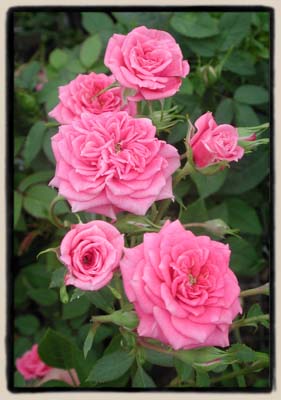 Left:
'Marie Shields', from a cross of 'Avandel' X 'Rougemoss',
introduced in 1988. Medium pink blooms in big clusters, with a
kind of Old Garden Rose blossom form, somewhat like a miniature
'Mme. Isaac Perriere'! A graceful plant growing to about
14 inches tall, always in bloom. Left:
'Marie Shields', from a cross of 'Avandel' X 'Rougemoss',
introduced in 1988. Medium pink blooms in big clusters, with a
kind of Old Garden Rose blossom form, somewhat like a miniature
'Mme. Isaac Perriere'! A graceful plant growing to about
14 inches tall, always in bloom. |
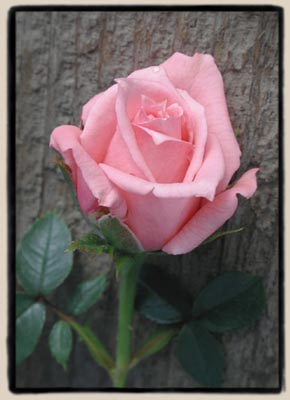 Right:
'English Porcelain', 1995. From a cross of 'Pink Petticoat'
X 'Happy Time'. Perfectly formed buds and blooms on a well
mannered, bushy plant. The color of this rose is exceptional;
a warm, translucent pink that is befitting the name. I can't imagine
why this wonderful rose isn't more well known. Right:
'English Porcelain', 1995. From a cross of 'Pink Petticoat'
X 'Happy Time'. Perfectly formed buds and blooms on a well
mannered, bushy plant. The color of this rose is exceptional;
a warm, translucent pink that is befitting the name. I can't imagine
why this wonderful rose isn't more well known. |
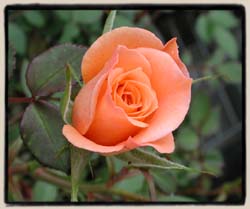 Left:
'Phyllis Shackelford ', from a cross of 'Anytime'
X 'Gold Badge', introduced in 1987. A strong grower, this
rose is, but never awkward or overly large. The color of the bloom
is best described as a creamy tangerine hue; orange, but not glaring
in its intensity. It always reminds me of the color of Creamsicles
we had as kids! As orange roses go, this one is easy to live with
and integrate into a garden scheme. Left:
'Phyllis Shackelford ', from a cross of 'Anytime'
X 'Gold Badge', introduced in 1987. A strong grower, this
rose is, but never awkward or overly large. The color of the bloom
is best described as a creamy tangerine hue; orange, but not glaring
in its intensity. It always reminds me of the color of Creamsicles
we had as kids! As orange roses go, this one is easy to live with
and integrate into a garden scheme. |
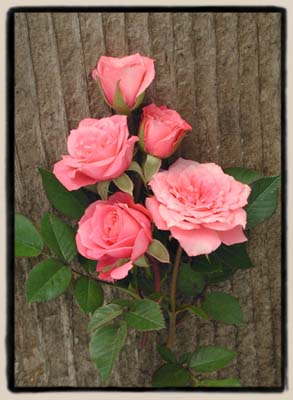 Right:
'Judy Fischer' from 1968. 'Little
Darling' X 'Magic Wand'. I seem to recall that
this is one of the early ARS Award of Excellence winners. Beautifully
formed coral-pink blooms produced continuously on a low-growing
healthy shrub about 16 inches tall. Considered to be a landmark
in Miniature rose breeding for its time, and still an excellent
garden performer well worth growing. Right:
'Judy Fischer' from 1968. 'Little
Darling' X 'Magic Wand'. I seem to recall that
this is one of the early ARS Award of Excellence winners. Beautifully
formed coral-pink blooms produced continuously on a low-growing
healthy shrub about 16 inches tall. Considered to be a landmark
in Miniature rose breeding for its time, and still an excellent
garden performer well worth growing. |
|
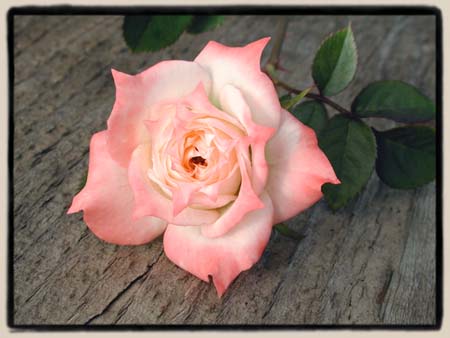 Left:
'Lifestyle' introduced in 1992. Breeding: 'Little
Darling' X 'Rainbow's End'. This has been a most
pleasant surprise in my garden this year. I don't usually go for
white roses with blush picotee but this one is exceptional. The
bloom form and coloring reminds me very much of the Hybrid Tea
'Gemini'. Blooms are produced one to a stem and in clusters
of 3, and they are always absolutely perfect in form and color.
Exquisite little rose, this is! Left:
'Lifestyle' introduced in 1992. Breeding: 'Little
Darling' X 'Rainbow's End'. This has been a most
pleasant surprise in my garden this year. I don't usually go for
white roses with blush picotee but this one is exceptional. The
bloom form and coloring reminds me very much of the Hybrid Tea
'Gemini'. Blooms are produced one to a stem and in clusters
of 3, and they are always absolutely perfect in form and color.
Exquisite little rose, this is!
|
|
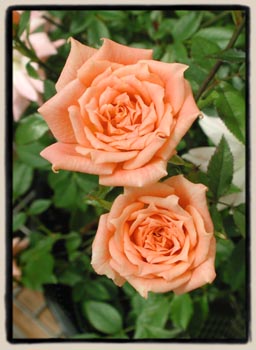 Right:
'Baby Darling', introduced in 1964. Again, this is
a cross of 'Little Darling'
X 'Magic Wand' which was made over and over at Sequoia
Nursery over many years. In fact, no fewer than 9 Moore roses
resulted from this particular combination of parents. Right:
'Baby Darling', introduced in 1964. Again, this is
a cross of 'Little Darling'
X 'Magic Wand' which was made over and over at Sequoia
Nursery over many years. In fact, no fewer than 9 Moore roses
resulted from this particular combination of parents.
This is one
of my very favorite Miniatures. It is free flowering in a way
that many more modern Miniatures don't even come close to. The
plant form is rounded and graceful, and the peachy colored blooms
are VERY fragrant, a rare trait in Miniatures. To my nose, this
rose smells of Lilac and Lily of the Valley! This is one of the
few older varieties that has truly stood the test of time and
will always have a place in my garden.
|
Part Two of this article
continued here
This
website made possible by a grant from the
Uncommon Rose

Original
photographs and site content © Paul Barden
1996-2003
|


 Every
year, new roses are introduced into commerce. Some of these are met
with a lukewarm response from the rose buying public, either because
they are not particularly good (or improved) hybrids or stylistically
they are not what rose growers are looking for. No matter what the reason,
many roses do not survive in commerce beyond their first 10 years after
release. If catalogs stop offering a variety, and the buying public
has moved on to thie current "bigger and better" model, whats
to stop that rose from slipping quietly into obscurity and on further
into extinction? Read on and we'll see.
Every
year, new roses are introduced into commerce. Some of these are met
with a lukewarm response from the rose buying public, either because
they are not particularly good (or improved) hybrids or stylistically
they are not what rose growers are looking for. No matter what the reason,
many roses do not survive in commerce beyond their first 10 years after
release. If catalogs stop offering a variety, and the buying public
has moved on to thie current "bigger and better" model, whats
to stop that rose from slipping quietly into obscurity and on further
into extinction? Read on and we'll see. At
a recent lecture on "Misunderstood Roses" by Andrew Schulmann, Andrew
pointed out an excellent example of a rose that nearly never made it
in commerce because it wasn't "the right shape": 'Moonsprite'. It was
a rose that would have been perfectly at home in the company of the
David Austin roses, but at the time of its introduction it was an oddity
and the public didn't take to it well. If it weren't for a few insightful
growers who recognized its merits, it may have been allowed to fall
into extinction. Therein lies the potential fate of most any rose thay
enters commerce. Even the darlings of the newest catalogs, harbingers
of a bright, bold new rose future are subject to the test of time. All
roses must pass this test, it seems; the Old Garden Roses we still have
in commerce remain with us today because they were deemed virtuous above
and beyond their peers, and thus were saved for future generations.
At
a recent lecture on "Misunderstood Roses" by Andrew Schulmann, Andrew
pointed out an excellent example of a rose that nearly never made it
in commerce because it wasn't "the right shape": 'Moonsprite'. It was
a rose that would have been perfectly at home in the company of the
David Austin roses, but at the time of its introduction it was an oddity
and the public didn't take to it well. If it weren't for a few insightful
growers who recognized its merits, it may have been allowed to fall
into extinction. Therein lies the potential fate of most any rose thay
enters commerce. Even the darlings of the newest catalogs, harbingers
of a bright, bold new rose future are subject to the test of time. All
roses must pass this test, it seems; the Old Garden Roses we still have
in commerce remain with us today because they were deemed virtuous above
and beyond their peers, and thus were saved for future generations.
 In
the 1960's, rosarians like Graham Thomas began assembling collections
of what remained of the old European roses from the 1800's and previous.
Thomas was certainly one of the first to recognize the need to gather
these roses for the enjoyment of future generations, but he was certainly
not alone in his quest in the decades to come. In America, dedicated
collectors began collaborating in an effort to collect, and in many
instances identify, the "lost" roses that grew hidden in old established
gardens and cemetaries. Banding together as entities such as the
In
the 1960's, rosarians like Graham Thomas began assembling collections
of what remained of the old European roses from the 1800's and previous.
Thomas was certainly one of the first to recognize the need to gather
these roses for the enjoyment of future generations, but he was certainly
not alone in his quest in the decades to come. In America, dedicated
collectors began collaborating in an effort to collect, and in many
instances identify, the "lost" roses that grew hidden in old established
gardens and cemetaries. Banding together as entities such as the  As
most of my readers must know by now, I am an ardent fan of Ralph Moore
and his hybrids. Moore roses have a certain feel about them; an unmistakeable
style that comes from decades of hybridizing refinement and careful
selection coupled with his unique and brilliant vision. Once upon a
time if you had asked me what I thought about miniature roses, my response
would have been a lukewarm "They're nice enough, if you go for
that sort of thing". That was before I met "the Master"
As
most of my readers must know by now, I am an ardent fan of Ralph Moore
and his hybrids. Moore roses have a certain feel about them; an unmistakeable
style that comes from decades of hybridizing refinement and careful
selection coupled with his unique and brilliant vision. Once upon a
time if you had asked me what I thought about miniature roses, my response
would have been a lukewarm "They're nice enough, if you go for
that sort of thing". That was before I met "the Master"  Left:
'Marie Shields', from a cross of 'Avandel' X '
Left:
'Marie Shields', from a cross of 'Avandel' X ' Right:
'English Porcelain', 1995. From a cross of 'Pink Petticoat'
X 'Happy Time'. Perfectly formed buds and blooms on a well
mannered, bushy plant. The color of this rose is exceptional;
a warm, translucent pink that is befitting the name. I can't imagine
why this wonderful rose isn't more well known.
Right:
'English Porcelain', 1995. From a cross of 'Pink Petticoat'
X 'Happy Time'. Perfectly formed buds and blooms on a well
mannered, bushy plant. The color of this rose is exceptional;
a warm, translucent pink that is befitting the name. I can't imagine
why this wonderful rose isn't more well known. Left:
'Phyllis Shackelford ', from a cross of 'Anytime'
X 'Gold Badge', introduced in 1987. A strong grower, this
rose is, but never awkward or overly large. The color of the bloom
is best described as a creamy tangerine hue; orange, but not glaring
in its intensity. It always reminds me of the color of Creamsicles
we had as kids! As orange roses go, this one is easy to live with
and integrate into a garden scheme.
Left:
'Phyllis Shackelford ', from a cross of 'Anytime'
X 'Gold Badge', introduced in 1987. A strong grower, this
rose is, but never awkward or overly large. The color of the bloom
is best described as a creamy tangerine hue; orange, but not glaring
in its intensity. It always reminds me of the color of Creamsicles
we had as kids! As orange roses go, this one is easy to live with
and integrate into a garden scheme. Right:
'Judy Fischer' from 1968. '
Right:
'Judy Fischer' from 1968. ' Left:
'Lifestyle' introduced in 1992. Breeding: '
Left:
'Lifestyle' introduced in 1992. Breeding: ' Right:
'Baby Darling', introduced in 1964. Again, this is
a cross of '
Right:
'Baby Darling', introduced in 1964. Again, this is
a cross of '